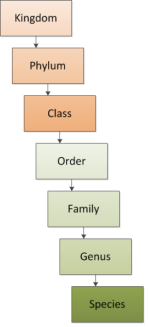Rob DuMoulin, Information Architect Knowledge Based Solutions, Inc.
Originally published 14-Mar-2010
http://hubdesignsmagazine.com/2010/03/14/is-it-taxonomy-season-already
Is it Taxonomy Season already?
Like death and taxes, every product-based Master Data Management (MDM) project undergoes a taxonomy definition exercise. During this time, Data Architects, like Accontants, come to realize if their payment of time thus far will yield a refund (of time) or require them to spend nights and weekends in jail (at the office). Let this article serve as your free consultation with your personal Taxonomy Preparation professional.
The taxonomy of biology burned into my memory to this day by my 6th grade science teacher, Mr. Head, contains the levels Kingdom, Phylum, Class, Order, Family, Genus, and Species. Any animal or plant can belong to one and only one of the lowest level, species. Each higher level of the taxonomy defines the inherited characteristics of its children. This accepted practice was put to the test in 1797 when Australian explorers returned to England with sketches of strange creatures. At first, the sketches depicting a furry egg-laying beaver-duck creature with venomous spines in its legs were regarded as either a practical joke or the result of some hallucination. When it became evident that this creature did exist, the scientific community struggled to classify it because such an abomination had ever been considered. The Platypus found a new home in the new Order, Monotremata, created to include mammals that lay eggs. In fact, archeological and living discoveries since them have added branches to the Family, Genus, and Species levels as well, making the Platypus not so rare after all.
The same concept is core to a product-based MDM design and the need for flexibility and adaptation is key. In an MDM taxonomy, each widget of an MDM topic can only reside in of the lowest taxonomy levels (for example products, people, or customer). At each level, this rigid hierarchy enforces inheritance of characteristics to all of its children and their children.
The number of levels in the MDM taxonomy vary based on the business need, topic, and a count of widgets in the topic. There are standards available to guide you in level counts and names if you want to follow them, but the assignment of attributes, definitions, and placement of your widgets in the structure is business-specific. Plan for a significant investment in effort to get the taxonomy and item assignments correct. This effort should result in the business agreeing on a taxonomy containing the fewest levels necessary to accurately represent the MDM topic widgets, along with a few other guidelines.
The topic of an MDM project may have many business purposes and be categorized by business users in a variety of different ways. This is expected and encouraged. We are not trying to restrict how the business analyzes the topic widgets. The taxonomy we are concerned with is a single hierarchy defining widgets through attribution characteristics as described in the prior biology example. We do this to create a single unambiguous definition that can be applied to every existing and new widget so that each widget falls under one and only one of the lowest taxonomy level. The business must validate the one widget per lowest taxonomy level rule, what attributes are common to each level, and that the attributes of any level apply to all levels below it. The taxonomy not only results in a standardized method of defining widgets but also allows for automatic inheritance of widget properties during definition which reduces the workload and chances of errors during the widget information entry.
Expect to encounter puzzled looks when introducing the concept of attribution-driven taxonomy. Business subject matter experts do not think of their widgets in those terms. Instead, they will be thinking in terms of how the business reports on the widgets. The distinction is clear only when you remember the purpose this taxonomy serves. Conducting workshops with business users across the board promotes the required consensus. After a few episodes of realigning discussions from a reporting mindset into an attribution mindset, the users will start to change their thinking and the results will be a valid taxonomy that the MDM can grow on. Without this foundation, your success will be limited.




